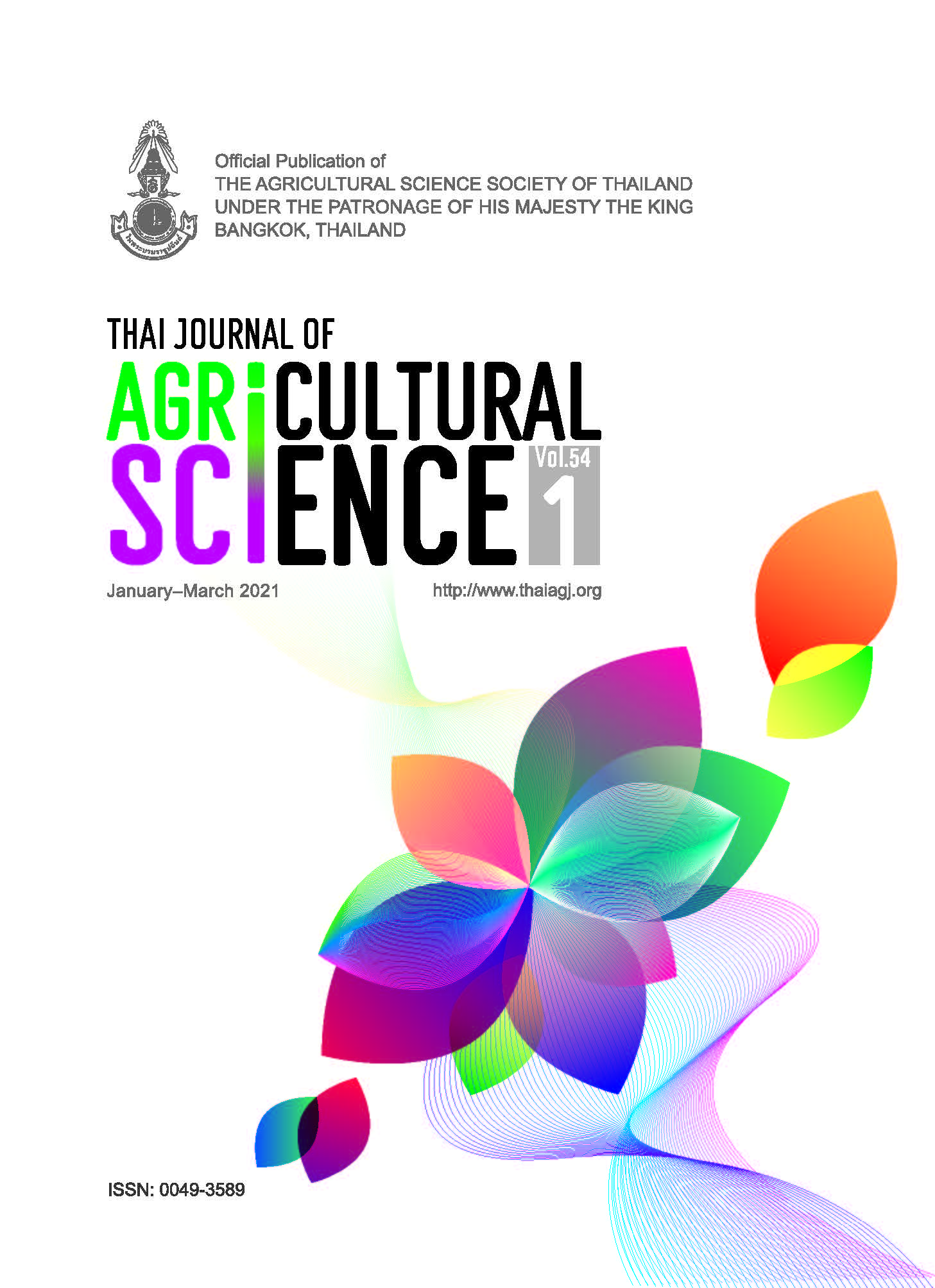In vitro chromosome doubling of tomato var. Improved Pope (Lycopersicon esculentum Mill) via colchicine
Main Article Content
Abstract
Prevailing biotic and abiotic stresses disrupt tomato seedling establishment, which may lead to yield and quality reduction. Colchicine, a common mutagen, prevents the development of microtubules during cell division resulting in chromosome doubling. Doubled chromosome plants have enhanced germination, shoot formation, leaf structure, and fruit size. Hence, in vitro mutation via colchicine was employed on tomato towards improved seedling characteristics for successful establishment. Seeds were treated with 0.05, 0.10, and 0.15% colchicine for four hours in completely randomized design. Seeds were cultured in vitro using Murashige and Skoog medium. Plant height (p < 0.001) was increased by 2.00 cm (SD 0.85) when applied with 0.05% colchicine. A higher dosage (0.10 and 0.15%) generally resulted in shorter plants wherein the shortest plant height was recorded on plants treated with 0.15% colchicine at 5.94 cm (SD 0.12), about half the height compared to plants not treated with colchicine at all. On root length (p < 0.001), all colchicine treated plants produced longer roots with the application of 0.05% colchicine producing the longest roots at 6.58 cm (SD 0.61). On stomata (p < 0.001), size (length and width) was generally increased with colchicine application where 0.05% colchicine application increased stomatal size at 17.99 mm (SD 0.62) and 16.42 mm (SD 0.62), respectively. The same was also recorded on chromosome size (p < 0.001) in which length and width was recorded at 21.28 mm (SD 0.66) and 15.20 mm (SD 0.50), respectively when exposed to 0.05% colchicine. Other parameters like percentage of germination and leaf size were also enhanced with the application of colchicine. Taken together, these improved characteristics can be implied to enhance the tomato seedling capacity for better field establishment.
Article Details
References
Berry, P.M. 2012. Lodging resistance in cereals. In: R.A. Meyers, (Ed.), Encyclopedia of Sustainability Science and Technology. Springer, New York, USA.
Bhowmik, D., K.P.S. Kumar, S. Paswan and S. Srivastava. 2012. Tomato–a natural medicine and its health benefits introduction. J. Pharmacogn. Phytochem. 1(1): 24–36.
Castro, M., S. Castro and J. Loureiro. 2018. Production of synthetic tetraploids as a tool for polyploid research. Web Ecol. 18: 129–141.
Chaves, M.M., J. Flexas and C. Pinheiro. 2009. Photosynthesis under drought and salt stress: regulation mechanisms from whole plant to cell. Ann. Bot. 103: 551–560.
Doheny–Adams, T., L. Hunt, P.J. Franks, D.J. Beerling and J.E. Gray. 2012. Genetic manipulation of stomatal density influences stomatal size, plant growth and tolerance to restricted water supply across a growth carbon dioxide gradient. Philos. Trans. R. Soc. Lond. B Biol. Sci. 367: 547–555.
Eng, W.H. and W.S. Ho. 2019. Polyploidization using colchicine in horticultural plants: a review. Sci. Hortic. 246: 604–617.
Ewas, M., E. Khames, K. Ziaf, R. Shahzad, E. Nishawy, F. Ali, H. Subthain, M.H. Amar, M. Ayaad, O. Ghaly and J. Luo. 2017. The tomato DOF daily fluctuations 1, TDDF1 acts as flowering accelerator and protector against various stresses. Sci. Rep. 7(1): 10299.
Griffiths, A.J.F., W.M. Gelbart, J.H. Miller and R.C. Lewontin. 1999. Changes in chromosome number. In: Modern Genetic Analysis. W.H. Freeman, New York, USA.
Kharkwal, M.C. and Q.Y. Shu. 2009. The role of induced mutations in world food security, pp. 33–38. In: G.Y. Shu, (Ed.), Induced Plant Mutations in the Genomics Era. Food and Agriculture Organization of the United Nations, Rome.
Kobayashi, N., S. Yamashita, K. Ohta and T. Hosoki. 2008. Morphological characteristics and their inheritance in colchicine–induced salvia polyploids. J. Japan. Soc. Hort. Sci. 77(2): 186–191.
Leigh, A., S. Sevanto, M.C. Ball, J.D. Close, D.S. Ellsworth, C.A. Knight, A.B. Nicotra and S. Vogel. 2012. Do thick leaves avoid thermal damage in critically low wind speeds?. New Phytol. 194: 477–487.
Manzoor, A., T. Ahmad, M. Bashir, I. Hafiz and C. Silvestri. 2019. Studies on colchicine induced chromosome doubling for enhancement of quality traits in ornamental plants. Plants 8: 194.
Mensah, J.K., B. Obadoni, P. Akomeah, B. Ikhajiagbe and J. Ajibolu. 2007. The effects of sodium azide and colchicine treatments on morphological and yield traits of sesame seed (Sesame indicum L.). Afr. J. Biotechnol. 6(5): 534–538.
Nahid, M., M.K. Borujeni and F. Bernard. 2015. Colchicine effect on the DNA content and stomata size of Glycyrrhiza glabra var. glandulifera and Carthamus tinctorius L. cultured in vitro. J. Genet. Eng. Biotechnol. 13(1): 1–6.
PSA (Philippine Statistic Authority). 2020. Major vegetables and root crops quarterly bulletin, October–December 2020: tomato. Available Source: https://psa.gov.ph/vegetable–root–crops–main/tomato. May 3, 2020.
Sarlikioti, V., P.H. de Visser, G.H. Buck–Sorlin and L.F. Marcelis. 2011. How plant architecture affects light absorption and photosynthesis in tomato: towards an ideotype for plant architecture using a functional–structural plant model. Ann. Bot. 108(6): 1065–1073.
Wang, Z., G. Fan, Y. Dong, X. Zhai, M. Deng, Z. Zhao, W. Liu and Y. Cao. 2017. Implications of polyploidy events on the phenotype, microstructure, and proteome of Paulownia australis. PLoS ONE 12(3): e0172633.
Zhai, Y., Q. Yang and M. Hou. 2015. The effects of saline water drip irrigation on tomato yield, quality, and blossom–end rot incidence–a 3a case study in the south of China. PLoS ONE 10(11): e0142204.


